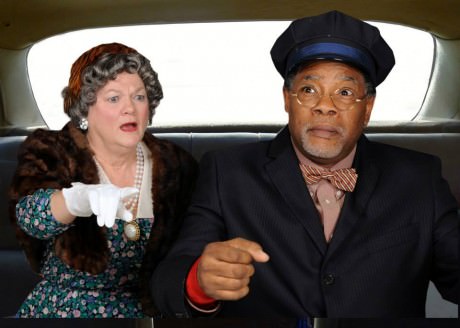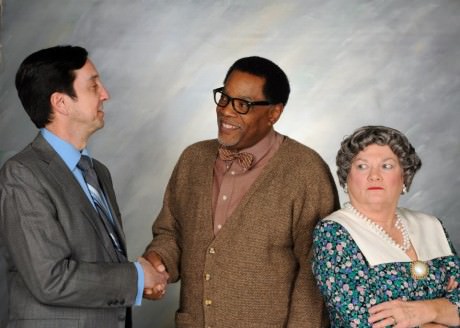Some things never change, even when we’re nearing the end. A person’s determination and stubborn nature does not go way of the wind simply because they can no longer do the things they used to do. If anything their determination and temper may flare all the more, which is exactly the case in the vividly boisterous production of Driving Miss Daisy at Dundalk Community Theatre this winter. Directed by Joey Hellman, this classic and heartwarming tale of age and sacrifices will touch your heart while giving you a good giggle along the way.

There is something to be said for a director who understands how to find the levities and humors in what would otherwise be a dreary and sad story. Director Joey Hellman has found the subtle nuances of comedy in this glowing tale of the age of acceptance and really works them to the audiences’ advantage. Moments that would otherwise idle in the weight of the play’s nature are reworked by Hellman to bring little laughs and chuckles to those watching without compromising the integrity of the play’s overall theme and message. Having the perfect cast for line delivery, Hellman’s production is splendid in all facets, moving with a brisk pace that allows the jokes to land just so while keeping the audience swept up in the story.
Atlanta, Georgia has a simplistic charm to its nature and Scenic Designer Marc W. Smith brings that southern hospitality into the setting that also transports the play back to the early 1950s. The elaborate sitting room eludes to Miss Daisy’s inherited wealth, rising up out of her impoverished upbringing, without flaunting it; a tactful approach to the classy main character. But it’s the platform levels of Smith’s design that are truly impressive. Each scene taking placing in a sharply focused light (also designed by Smith) so that the scenes roll along like little interconnected vignettes. The lights rise and set on these varying levels individually creating segments of other locations all contained within one stage; a brilliant blocking and design technique that allows the play and its characters to traverse many locations without needing elaborate furnishings or backdrops.
The one drawback to Smith’s brilliant set is the time that the audience spends in darkness between scenes while the three actors traverse these platforms. Occasionally there is music to expedite and entertain during said changes, but there are a few that fall to total silence and provide a hiccup of disconnect between what has just happened and what is about to happen. Although these moments do not occur often, when they do (because the play runs otherwise so smoothly) they are sharply noticeable.
While Hoke and Boolie never see much by the way of wardrobe, Costume Designer James J. Fasching really pulls out all the stops for the title character. With dresses, hats, robes, nightgowns, and coats in all sorts of colors and patterns, Daisy looks her absolute best even when she’s not feeling her best. Fasching finds fashions that are age appropriate while still recalling a touch of class and elegance to Daisy, again imbuing that aristocratic sense of humble riches to her character.
Boolie (Jim Knost) is a minor character that does appear frequently enough to make a major difference in the plot. Knost’s exceptionally thick and strong southern accent rings through in every word that he speaks, really grounding him in his Georgian roots. It’s his sharp but subtle ease with comic timing that allows his character to exist in the finer and funnier moments of this play, making him fit naturally into the little jokes that are carefully worked into the dialogue. Knost carries a concerned but proud nature about his character; keeping the focus on Daisy as the play progresses, even when most of her scenes are shared interacting with Hoke.
Hoke (William A. Walker) and Miss Daisy (Carol Conley Evans) are quite the pair. The working relationship between the two is amazing; a slow progression from embittered enemies— mainly on the side of Daisy disliking Hoke— to dear and trusted friends. The relationship that grows between them during the duration of the play feels genuine; a shared chemistry that blossoms in their banter and flourishes in their time spent together.
Walker has a thorough grasp of the southern dialect used by his character but it is his comic delivery that really makes Hoke shine. Understanding exactly how to deliver a line, exactly where to hold a pause or wait for a split second before returning a bit of banter, Walker gives an exceptionally witty and humorous portrayal in this role. His tender nature and kind heart radiates through the character’s interactions with Daisy even when she’s being trying. Keep a close eye on his silent responses as well, often characterized by his vivid facial expressions.
Evans, as the stubborn Miss Daisy, is a delight in the role, playing it with a familiarity and flare that keeps the audience roaring at her funnier moments, and moved deeply by her more serious ones. Evans finds the perfect balance between her cantankerous biting nature and the more tender moments that her character struggles to accept. Evans brings an honest humanity to the role, leading the audience and other characters to empathize with Daisy; we love her and laugh along in her situations while she tugs at our heartstrings. Evans’ portrayal lets everyone find a little of their own mother or grandmother in Daisy, making her genuine and relatable to all watching; a truly magnificent performance from laughing biting beginning to harrowing bittersweet end.

Dundalk Community Theatre’s Driving Miss Daisy is a wonderful production and is a perfect outing for a good laugh – and maybe a little bit of a cry as well.
Running Time: Approximately two hours, with one intermission.
Driving Miss Daisy plays through March 2, 2014 at Dundalk Community Theatre— College of Baltimore County in Building K, at the John E. Ravekes Theatre – 7200 Sollers Point Road, in Baltimore, MD. For tickets, call the box office at (443) 840-2787, or purchase them online.
https://youtu.be/uOlaYT0e9Co




